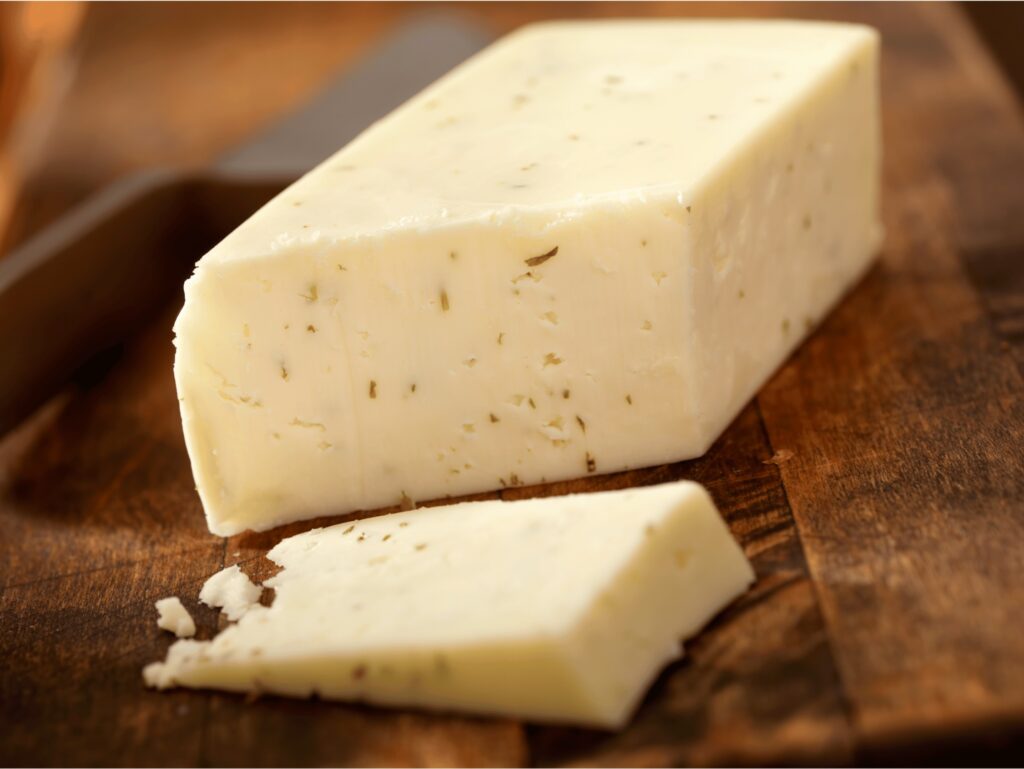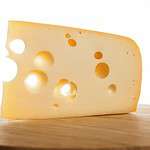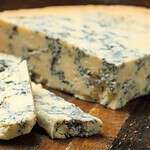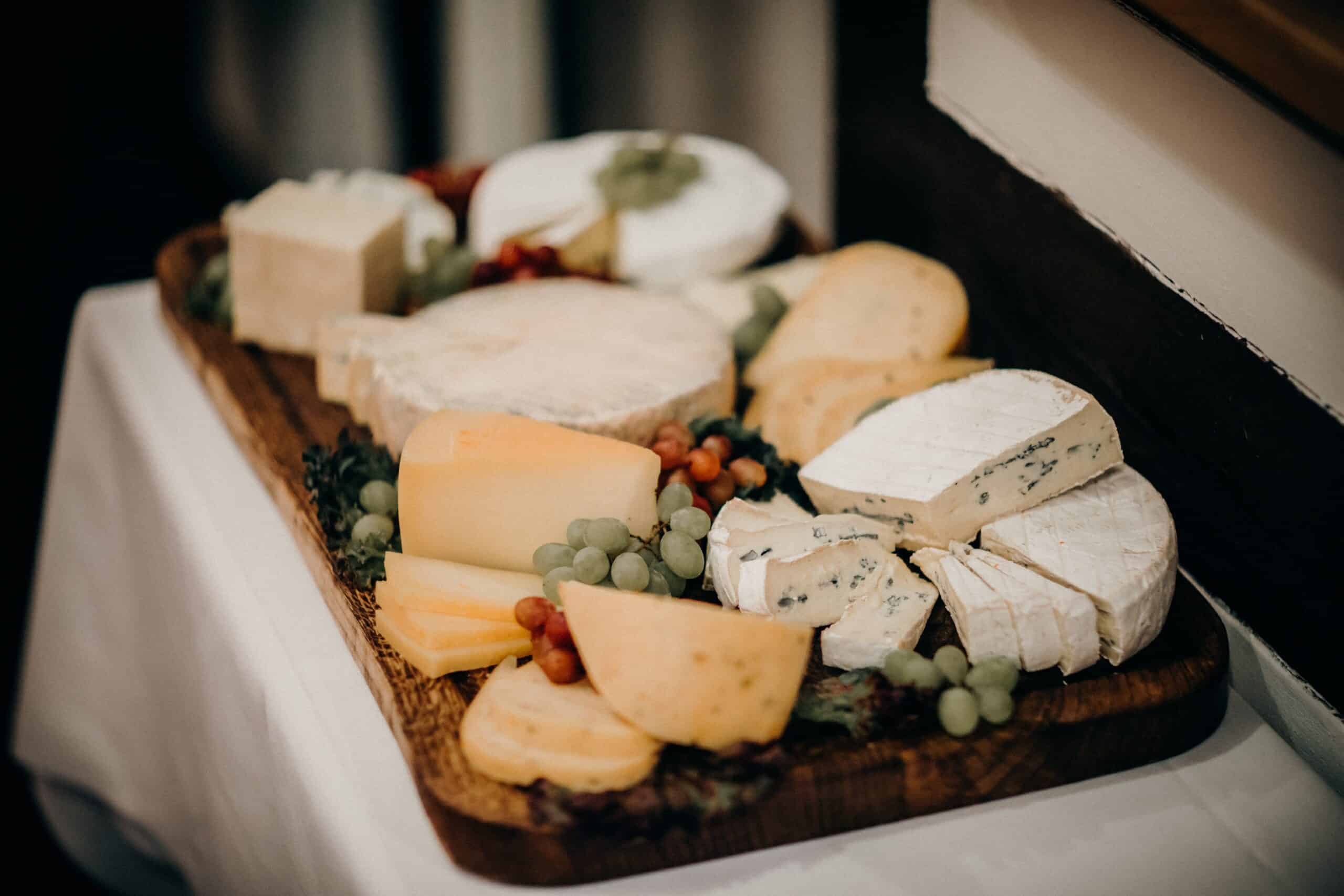Havarti cheese is a semi-soft Danish cow’s milk cheese that has become popular worldwide for its mild flavor and creamy texture. It originated in the 19th century on a farm in Denmark, inspired by a farmer’s wife who wanted to create a new type of cheese. Over time, Havarti has gained recognition for its versatility in both cooking and consumption as a table cheese.
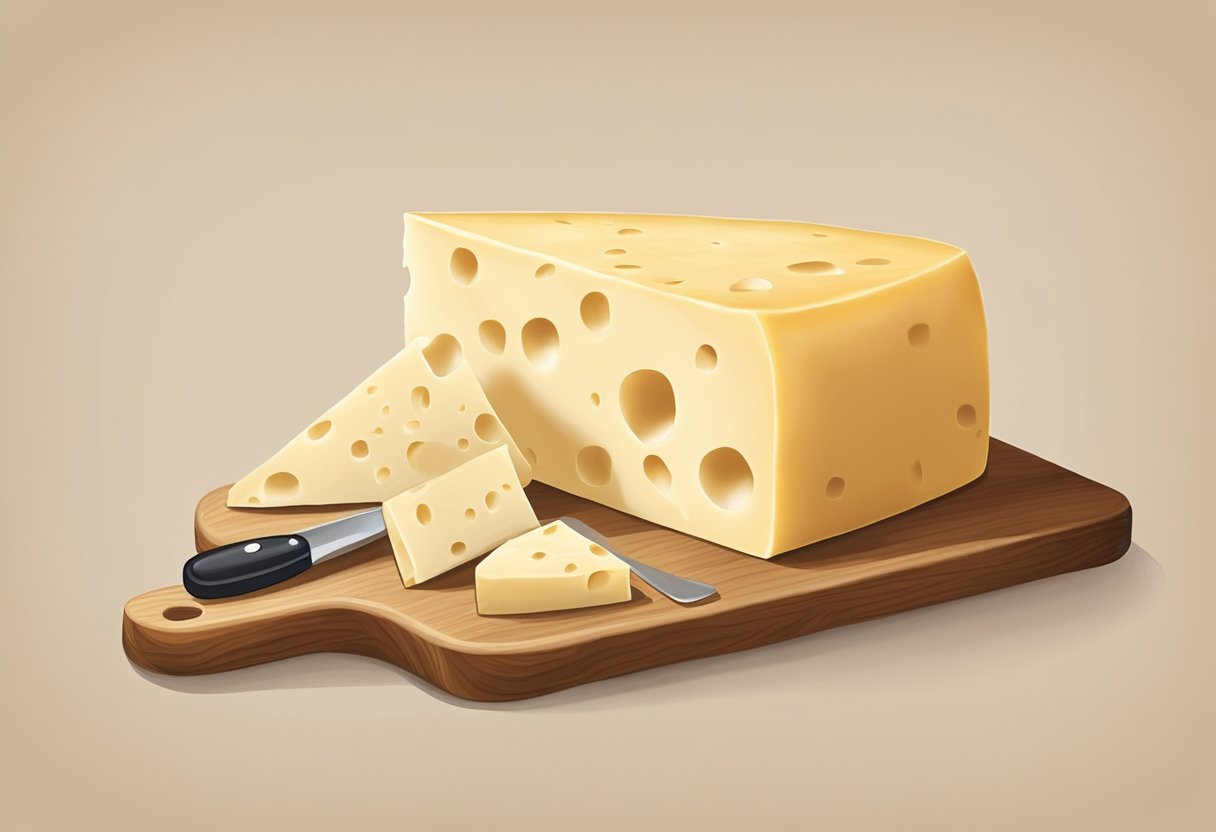
The characteristics of Havarti cheese are distinguished by its rindless, smooth surface and cream-to-yellow color. It often contains small, irregular holes known as “eyes,” though the cheese is not as holey as a Swiss cheese. Havarti cheese can vary in taste from buttery and mild to slightly acidic and tangy, depending on its age. Its supple and creamy consistency makes it a favored choice for melting and incorporating into a variety of dishes.
Production of Havarti follows traditional cheese-making processes but has evolved with modern techniques, creating an array of Havarti varieties—from plain to spiced, aged, or smoked. The nutritional profile of Havarti cheese is similar to other semi-soft cheeses, providing a good source of protein and calcium but also being rich in fat. In terms of kitchen use, Havarti’s excellent melting characteristics make it suitable for sandwiches, pastas, and sauces, while its smooth texture allows it to blend well into slices for cheese boards.
Key Takeaways
- Havarti is a versatile Danish cheese with a creamy texture and a mild to tangy flavor.
- It’s well-suited for various recipes due to its melting properties and is a nutritious addition to meals.
- The production of Havarti has adapted over time, offering a variety of flavors and styles to suit different preferences.
History and Origin
Havarti cheese has a rich history rooted in Denmark’s dairy tradition, explicitly crafted to embody a mild yet distinctive flavor. We will explore its journey from local Danish kitchens to international acclaim.
Danish Roots
In the mid-19th century, within the fertile pastures of Denmark, Havarti was born out of the Danish farming community’s skilled practice in cheese-making. This cheese quickly gained a reputation for its creamy texture and subtle taste, which were attributable to the high-quality milk from Danish cows. The traditional method of making Havarti involves a unique process of curdling, draining, and pressing which has been carefully honed and preserved over generations in Denmark’s rural heartlands.
Hanne Nielsen’s Contribution
Hanne Nielsen, a Danish pioneer in cheese-making, greatly influenced Havarti’s development. In the 1800s, she returned to Denmark after studying dairy techniques in various European countries and applied these methods to our local cheese-making practices. Particularly famous was her creation of a semi-hard cheese, named after her family’s farm, Havarti. Her innovative approach to aging and curdling gave Havarti its appreciated buttery consistency and delicate porosity which led to its unique taste and texture that we treasure in Danish food culture.
Characteristics of Havarti Cheese
Havarti cheese is renowned for its distinctive texture and rich flavor profile, accommodating a variety of taste preferences through its several varieties and added flavorings.
Texture and Taste
Havarti boasts a smooth texture that can range from semi-soft to semi-firm, depending on its aging. Fresh Havarti has a creamy consistency that melts effortlessly in the mouth. The taste of this cheese is typically described as mild and buttery, with a slight sweetness that makes it versatile for both cooking and direct consumption.
Varieties and Flavorings
We find a selection of Havarti cheeses available, each with unique inclusions to boost their inherent qualities. The classic Cream Havarti contains more fat, giving it a richer and creamier taste. For those who enjoy more intensity in their cheese, variants with spice infusions, such as dill, caraway, and horseradish, provide a zestier tasting experience. The addition of these herbs and spices not only enhances the flavor but also contributes to a more aromatic experience.
Production Process
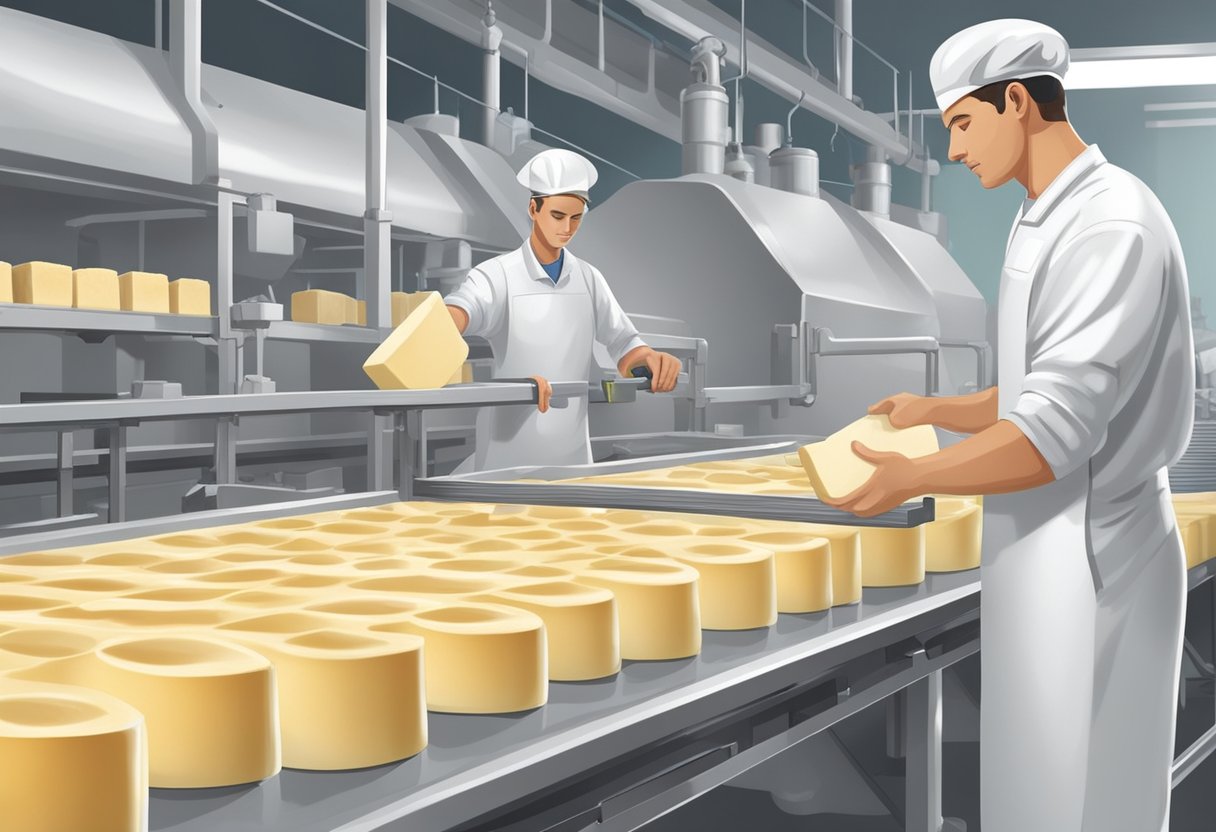
In producing Havarti cheese, we follow a meticulous process that ensures the cheese’s distinct creamy texture and mild, buttery taste. From selecting the right combination of milk and cream to the careful aging that develops its unique flavor profile, each step is crucial to yield the final product.
Milk and Cream Selection
We begin our process by sourcing high-quality milk and cream. It is vital that these ingredients are fresh and creamy, which are essential for the rich flavor and texture of Havarti. We often use a mix of cow’s milk known for its high butterfat content and cream to provide the desired fat level in the cheese.
Curdling and Mold Use
The next phase is the introduction of culture to the milk and cream mixture. The culture is responsible for fermenting lactose into lactic acid, setting the stage for curdling. Then, rennet is added to further curdle the milk, turning it into curds and whey. We transfer the curds into cheese molds where they take shape and start to drain.
Salting, Rennet, and Culture
Salting is a critical step for flavor and preservation. We add salt to the curds after they’ve been placed in molds. The salt aids in drawing out moisture and acts as a natural preservative. Alongside salt, calcium chloride may be added to help the curds set, enhancing the cheese’s final texture. The rennet and culture work in synergy to develop Havarti’s characteristic body and taste.
Aging and Maturation
Finally, Havarti’s distinctive character emerges through the aging process. We carefully store the cheese under controlled conditions, allowing it to mature over time. The duration of this aging process can vary, typically ranging from a few weeks to several months, depending on the desired intensity of flavor. Aging allows Havarti to develop its creamy consistency and the subtle complexity of its taste profile.
Nutritional Profile
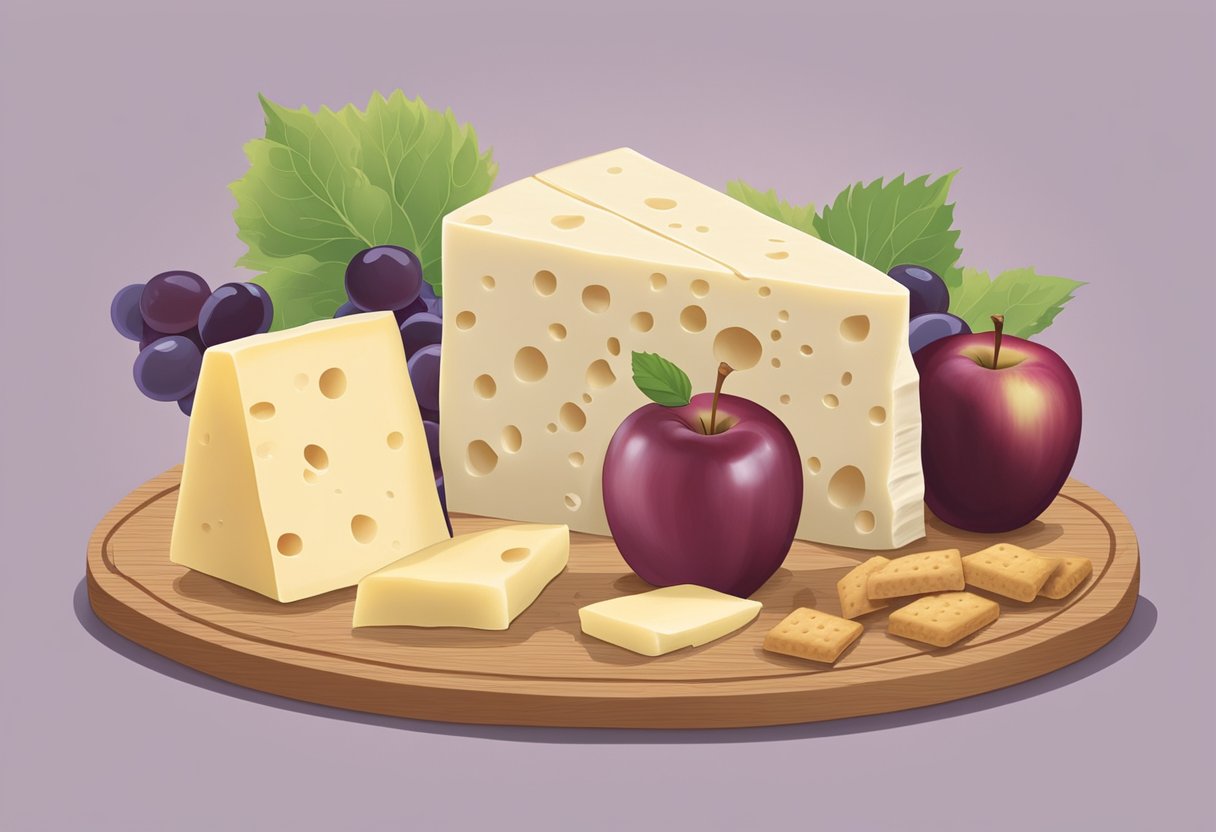
When we examine the nutritional profile of Havarti cheese, we find that it is a rich source of various nutrients. A standard serving of Havarti, which is approximately 1 ounce (28 grams), typically contains the following:
- Calories: 110
- Protein: 6 grams
- Carbohydrates: 0 grams
- Total Fat: 9 grams
- Saturated Fat: 5 grams
- Fiber: 0 grams
- Calcium: 200 mg
It’s important for us to note that Havarti cheese is relatively high in fat, especially saturated fats. Despite the high fat content, the cheese contains no fiber and is low in carbohydrates, making it a keto-friendly option.
As for protein, we find Havarti offers a decent amount, contributing to muscle maintenance and repair. This aspect is especially useful for individuals following a high-protein diet.
In regards to calcium, our assessment shows that Havarti cheese is an excellent source of this mineral, which is vital for bone health and the functioning of the heart, muscles, and nerves.
Remember that nutritional values can vary based on the specific brand and type of Havarti cheese, but the figures provided here give us a general understanding of its nutritional profile. Always check the label of the specific product for the most accurate information.
Havarti Cheese in the Kitchen
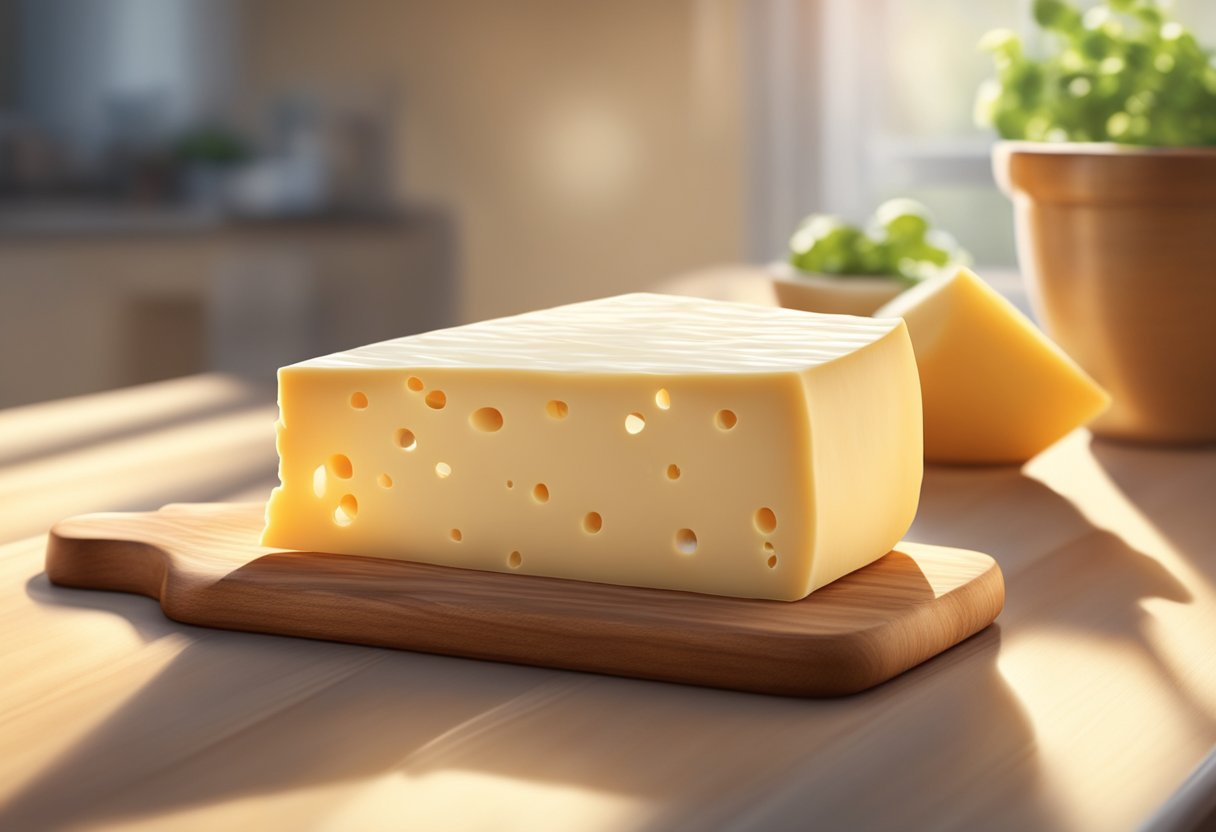
In our exploration of Havarti cheese within the kitchen setting, we focus on its unique characteristics when cooked and paired with other foods.
Cooking and Melting Properties
Havarti cheese boasts excellent melting qualities, making it a versatile choice for various culinary applications. It has a buttery, creamy texture that becomes even smoother when melted. We find it particularly suitable for grilled cheese sandwiches, where its meltiness creates a luxurious texture. Similarly, in a macaroni and cheese dish, Havarti provides a rich and creamy consistency that complements the pasta, ensuring a balanced, cohesive flavor throughout.
Food Pairings and Combinations
Our experience with Havarti cheese has shown that it pairs exceptionally well with a variety of foods:
- Fruits: Apples and pears
- Honey: A drizzle of honey provides a sweet contrast to Havarti’s mildly tangy profile.
- Vegetables: Great with roasted or grilled vegetables
For a tailored table of Havarti pairings:
| Dish Type | Havarti Pairing Suggestions |
|---|---|
| Burgers | Adds a creamy touch without overpowering the meat |
| Grilled Cheese Sandwich | Serves as a gooey, flavorful base layer |
| Pasta | Elevates dishes like macaroni & cheese or cheese sauces |
In this way, we incorporate Havarti into our culinary repertoire, ensuring a broad spectrum of delightful flavors enhanced by this adaptable cheese.
Cheese Comparisons
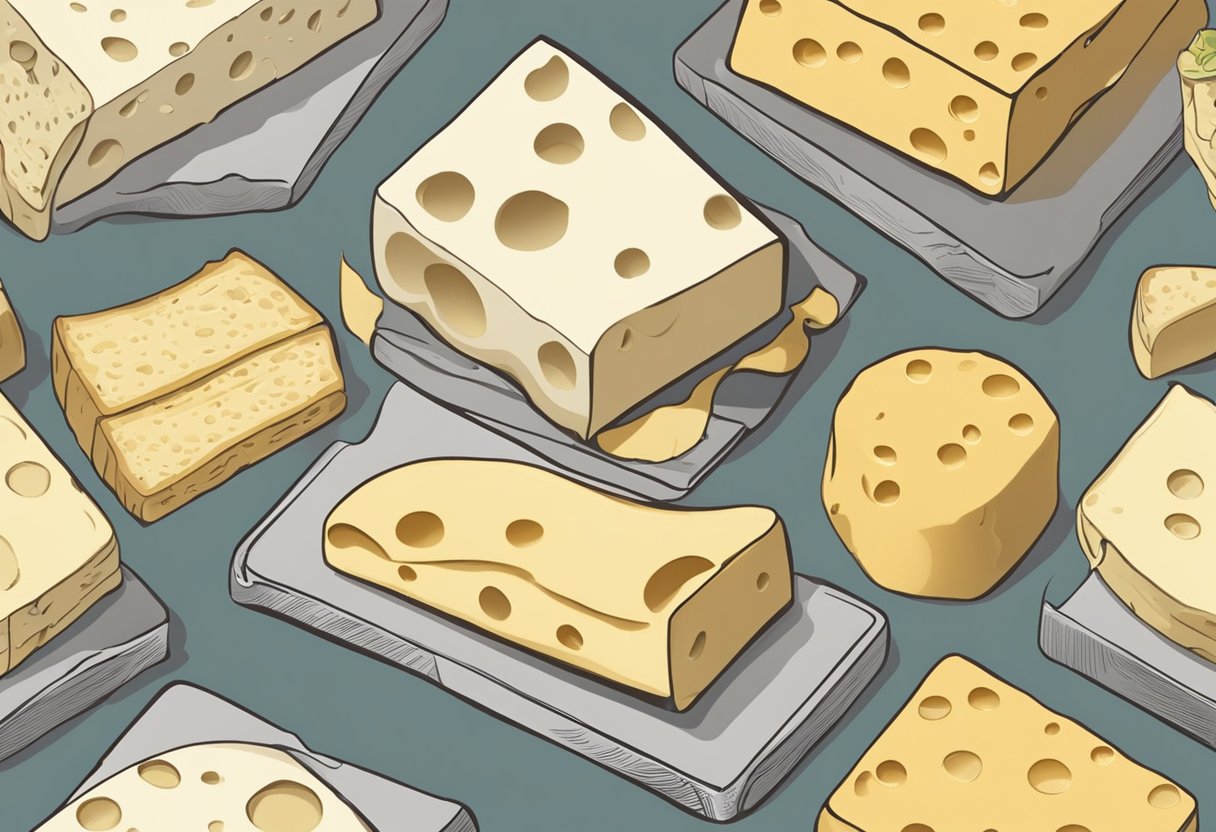
In this section, we’ll take a close look at how Havarti, a popular semi-soft cheese, stands up to various other types of cheese.
Havarti Versus Other Cheeses
Swiss Cheese:
- Texture: Havarti is creamier and smoother than Swiss cheese, which has a firmer texture.
- Taste: Swiss cheese is known for its mild, nutty flavor and iconic holes, while Havarti has a buttery and slightly tangy taste.
Gouda:
- Aging: Gouda can be found in younger or aged varieties; Havarti is typically aged for a shorter period, resulting in its softer texture.
- Flavor Profile: Aged Gouda has a stronger, sweeter, and sometimes caramel-like flavor compared to the milder and more delicate Havarti.
Cheddar:
- Texture: Cheddar varies from semi-hard to hard texture as it ages, whereas Havarti consistently maintains a semi-soft consistency.
- Sharpness: Cheddar’s flavor becomes increasingly sharp and intense with age, contrasted with Havarti’s consistently mild and creamy flavor.
Monterey Jack:
- Texture Similarity: Both cheeses are semi-soft, although Monterey Jack is slightly firmer than Havarti.
- Flavor: Monterey Jack is milder and often used in melting applications just like Havarti; however, Havarti offers a more pronounced buttery taste.
Hard Cheeses (e.g., Parmesan, Aged Pecorino):
- Texture: These hard cheeses are much dryer and crumblier than Havarti.
- Uses: While hard cheeses are often used for grating over dishes, Havarti’s meltability makes it ideal for sandwiches and creamy sauces.
Our exploration highlights Havarti’s unique position in the cheese spectrum, offering a distinct, creamy texture and a mild yet tangy flavor that distinguishes it from other semi-soft and hard cheese counterparts.
Serving and Storage
When we serve Havarti cheese, we usually present it at room temperature to enhance its natural flavors. Havarti’s springy texture and creamy body make it highly versatile, suitable for slicing and melting. Since it’s sliceable, we often cut it into thin slices for sandwiches or thicker pieces for cheese platters.
For Storage:
- Wrap Havarti in cheese paper or parchment, avoiding plastic wrap if possible to let it breathe.
- Refrigerate it in the vegetable drawer or a dedicated cheese drawer, which is typically less cold and more humid.
- Store away from strong-smelling foods as Havarti can absorb other odors due to its creamy body.
A Quick Guide:
| Aspect | Detail |
|---|---|
| Texture & Serving | Springy, sliceable – best served at room temp. |
| Pairing | Pairs well with fruit, bread, and wine. |
| Shelf Life | Consume within two weeks for optimal freshness. |
| Storage Temp. | Keep in the fridge at 35°F to 45°F (1.7°C – 7.2°C). |
Remember, Havarti is rindless, so it’s entirely consumable and perfect for dishes that require a meltable cheese. We can toast it for a rich and gooey sandwich filling, or incorporate it into our cooking for a decadent creamy sauce.
Pairing with Beverages
When we consider Havarti cheese, we find that its buttery and slightly tangy flavor profile makes it a versatile partner for a variety of beverages. Wines, both white and red, can complement the creamy texture and subtle taste of Havarti.
Starting with white wines, a crisp Sauvignon Blanc is an ideal match. Its zesty acidity and citrus notes bring out the best in Havarti by cutting through the cheese’s creaminess and highlighting its tangy character.
| White Wine Varietal | Notes | Why It Pairs Well |
|---|---|---|
| Sauvignon Blanc | Zesty, Citric, High Acidity | Balances creaminess of Havarti |
For those who prefer red wines, a Merlot with its smooth tannins and fruity essence can be a delightful accompaniment. The Merlot works well with younger Havarti, which tends to be milder in flavor.
| Red Wine Varietal | Notes | Why It Pairs Well |
|---|---|---|
| Merlot | Smooth, Fruity, Low Tannins | Complements mild Havarti |
Saison, a type of pale ale, is another excellent choice for pairing with Havarti. Its moderate to high carbonation and range of spicy, fruity, and sometimes tart flavors, align beautifully with Havarti’s creamy and supple nature. The effervescence of a well-brewed Saison cleanses the palate and sets the stage for the next bite of cheese.
| Beverage Type | Characteristics | Why It Pairs Well |
|---|---|---|
| Saison | Spicy, Fruity, Effervescent | Cleanses palate, contrasts texture |
Through these pairings, we aim to enhance the Havarti tasting experience by complementing its flavors and mouthfeel with the right beverage choice.
Global Perspectives
As we examine the reach of Havarti cheese, it becomes evident that its popularity extends beyond its Danish origins, influencing cheese cultures and consumption habits around the globe.
Havarti’s Popularity Worldwide
Havarti, originally from Denmark, resonates with cheese lovers internationally. In France, a nation celebrated for its cheese connoisseurship, Havarti holds a niche but cherished position. French consumers appreciate its creamy texture for both table cheese and culinary applications, although it is not as pervasive as traditional French cheeses.
Moving across the Atlantic, the United States has embraced Havarti with enthusiasm. This cheese has found its way into supermarkets and specialty stores alike, with American consumers enjoying its versatility. It can be found sliced in sandwiches, melted into comfort foods, or served on cheese platters.
Particularly, Wisconsin, known as “America’s Dairyland,” has developed a significant appreciation for Havarti. Wisconsin cheesemakers produce their own versions of this semi-soft cheese, contributing to the state’s diverse cheese repertoire. The Wisconsin Cheese community respects the traditional Danish methods while also exploring new flavors through unique aging processes and the addition of herbs and spices.
Havarti’s mellow yet distinctive taste makes it a favorite for both cheese plates and in recipes, adding a touch of Danish tradition to meals and snacks around the world.
Havarti at Home
Creating Havarti cheese in the comfort of our own kitchen allows us to experience the art of cheese-making firsthand. We can tailor the flavors to our liking and ensure the quality of the ingredients used.
Homemade Havarti Making
To begin our journey of making Havarti at home, we must gather all necessary equipment including a thermometer, spoon, knife, and other cheese-making essentials. Here is a simplified outline of the process we’ll follow:
-
Ingredients & Preparation: We will need raw milk as the base for our Havarti. Starting with high-quality, fresh milk is crucial for the final flavor profile.
-
Heating the Milk: Heat the raw milk to the correct temperature, carefully monitored with our thermometer, initiating the cheese-making process.
-
Curdling: We add a coagulant to separate the curds from the whey. Gentle stirring with a spoon helps ensure even curdling.
-
Curd Cutting: Once curdled, we’ll cut the curds using a knife to allow whey to release. The size of the curds can affect the moisture of our Havarti.
-
Pressing and Shaping: After draining the whey, we press the curds into molds to form the cheese’s shape.
-
Curing: The cheese then needs to be aged for at least 4 weeks to develop the characteristic Havarti flavor.
Table 1: Havarti-Making Essentials
| Equipment | Purpose |
|---|---|
| Thermometer | To monitor the milk’s temperature |
| Spoon | For stirring and curd separation |
| Knife | To cut the curds for whey release |
| Cheesecloth | To strain and shape the curds in molds |
| Press | To apply pressure to form the cheese |
Making Havarti at home requires patience and attention to detail, but the result is a delightfully creamy and uniquely flavored cheese that we can take pride in crafting ourselves.
Shopping for Havarti
When we shop for Havarti, we prioritize finding authentic selections that focus on quality and flavor. Here are some factors to consider:
Milk: We look for Havarti made with pasteurized milk for safety and consistency. This form of milk ensures the cheese is free from harmful bacteria, while still providing rich flavor.
Cheese Characteristics: We seek out interior-ripened cheese as this is characteristic of traditional Havarti. Typically, it will have small irregular holes throughout, indicating proper maturation and development of flavor.
Age: While all Havarti is delightful, the age can influence its taste and texture. Aged Havarti has a stronger, more pronounced flavor, while younger cheeses are milder. We take into account the age based on the desired taste profile, though all age ranges tend to have a satisfying creamy consistency.
Flavor and Versatility: We enjoy Havarti for its balanced flavor that’s often buttery and slightly tangy. This makes it a versatile cheese, suitable for various dining scenarios, from sandwiches to cheese boards.
| Cheese Aspect | What We Look For |
|---|---|
| Source of Milk | Pasteurized milk for safety and consistency. |
| Maturation | Interior-ripened with small, irregular holes. |
| Texture | Creamy consistency across ages. |
| Flavor | Balanced, suitable for various culinary uses. |
We ensure our Havarti choices are reflective of these qualities, which contribute to its overall appeal on the palate. When selecting, we also consider the specific use, pairing options, and personal preference for age and flavor nuances.
Innovations and Variations
In our exploration of Havarti cheese, we witness a plethora of flavors that have emerged over time. These innovative varieties cater to a broad spectrum of palates, each infusing the creamy and semi-soft base with unique tastes and aromas.
Flavored Havarti Varieties
-
Dill Havarti: We find the herbaceous overtones of dill mingling seamlessly with Havarti’s buttery profile. This variety often contains visible bits of dill weed, offering a fresh and slightly tangy flavor ideal for sandwiches and salads.
-
Jalapeño Havarti: For those who prefer a spicy kick, the Jalapeño Havarti introduces a warm, peppery heat. The jalapeño peppers interlace with the cheese’s mildness, creating a balance that ignites the taste buds without overwhelming them.
-
Garlic Havarti: Garlic infuses an aromatic intensity into Havarti, adding a savory depth that pairs well with meats and crusty breads. It’s a bold choice for those who relish the robust essence of garlic.
-
Caraway Havarti: Bringing an earthy, anise-like flavor profile, Caraway Havarti contains caraway seeds. This version complements rye bread and is often used in traditional Scandinavian sandwiches.
-
Horseradish Havarti: A zesty and pungent punch characterizes the Horseradish Havarti. It’s a perfect match for roast beef and adds an exciting dimension to cheese platters.
Table of Havarti Flavor Pairings:
| Flavor | Pairing Suggestion |
|---|---|
| Dill | Sandwiches, Salads |
| Jalapeño | Spicy dishes, Nachos |
| Garlic | Deli meats, Breads |
| Caraway | Rye Sandwiches, Cold Cuts |
| Horseradish | Roast Beef, Hearty Meals |
In this evolving cheese landscape, we have relentlessly sought and embraced innovations within Havarti varieties to satisfy a medley of flavor preferences and culinary applications.
Health and Dietary Considerations
When we consider Havarti cheese in the context of health and dietary considerations, we must first acknowledge that it contains dairy. Therefore, for individuals with dairy allergies or lactose intolerance, consuming Havarti cheese may result in adverse reactions. Lactose intolerance can cause symptoms such as abdominal pain, bloating, and diarrhea, so it’s important to be aware of your body’s response to dairy products.
Havarti is a rich source of calcium and protein, which are essential for bone health and muscle maintenance. It also provides important vitamins such as Vitamin A and B12, as well as minerals like zinc, phosphorus, and riboflavin. However, like many cheeses, Havarti is high in saturated fats and sodium, which should be consumed in moderation to maintain a balanced diet and cardiovascular health.
| Nutrient | Benefit |
|---|---|
| Calcium | Aids in bone health and density |
| Protein | Essential for muscle repair and growth |
| Vitamin A | Important for vision and immune functionality |
| Vitamin B12 | Crucial for nerve function and red blood cell formation |
| Saturated Fats | Should be limited to avoid cardiovascular risk |
In terms of calories, Havarti cheese typically contains about 110 calories per ounce, and it’s often recommended to measure portions to avoid overconsumption.
We should also consider the fat content in Havarti cheese when incorporating it into a balanced diet. A single serving provides around 9 grams of fat, which includes both saturated and unsaturated fats. Mindful eating of Havarti cheese allows us to enjoy its flavors while adhering to a diet that supports our overall health goals.
Culinary Techniques and Recipes
Havarti cheese is versatile in the kitchen, offering a creamy texture and mild flavor ideal for various recipes. Our focus is on its integration into culinary techniques that showcase its unique qualities.
Creative Uses in Cooking
When baking with Havarti, we prefer it in dishes where its creamy meltability can shine, such as in a rich quiche or bubbling on top of a hearty lasagna. Its buttery flavor melts smoothly, making it a fantastic addition to sauces and fillings where cheese is featured prominently. For a simple, yet delectable use, consider the following table illustrating a classic Havarti grilled cheese sandwich process:
| Step | Instruction |
|---|---|
| 1 | Choose your bread: Opt for a bread that crisps well, like sourdough or a rustic artisan loaf. |
| 2 | Add Havarti: Slice Havarti thinly to ensure even melting and layer onto the bread. |
| 3 | Butter & Grill: Apply butter to the outside of the sandwich for a golden crust and grill over medium heat. |
| 4 | Flip carefully: Once golden on one side, flip to achieve the same perfection on the other. |
| 5 | Serve warm: Ensure the Havarti’s smooth texture by serving the sandwich immediately after cooking. |
Keep in mind that Havarti’s melting qualities make it ideal for a grilled cheese sandwich that’s both gooey and flavorful. We can enhance the sandwich further by incorporating ingredients such as tomatoes, basil, or even slices of apple for a sweet and savory twist. Remember, the simplicity of Havarti allows it to blend seamlessly with other ingredients, so we encourage experimentation to find the perfect flavor combinations.
Understanding Cheese Types
In our exploration of cheese varieties, we focus on Havarti, a table cheese favored for its versatility and pleasing taste which resonates with a broad range of palates.
Classifying Havarti
Havarti is a semi-hard cheese that originated from Denmark in the mid-19th century. It is often classified as a table cheese, meaning it’s primarily consumed on its own or as part of various dishes at the dining table, rather than being used primarily for cooking or grating. What sets Havarti apart in the vast cheese spectrum is its creamy consistency and gentle flavor, which make it an approachable choice for most cheese enthusiasts.
We understand Havarti by its texture and taste profile. It’s characterized by its semi-hard texture, which is firmer than soft cheeses like Brie yet softer than hard cheeses like Parmigiano-Reggiano. This balance gives Havarti a unique position in cheese selections, as it is soft enough to be sliced easily yet retains enough structure to avoid oozing at room temperature.
Havarti’s appeal to a wide range of palates comes from its subtle flavors. It’s slightly acidic but also buttery, which allows it to complement other foods without overpowering them. This quality makes it a versatile cheese that can enhance the taste of sandwiches, crackers, fruit, and more. Its creaminess is particularly well-received in cheese assortments and pairs well with a variety of wines and beers.
Artisanal Versus Commercial Havarti
Artisanal Havarti is traditionally crafted in small batches, ensuring keen attention to the cheese’s texture and flavor. We often find that artisanal producers use local milk, adding a unique taste representative of their specific region. The process is usually hands-on, involving meticulous stirring, cutting of curds, and pressing.
| Aspect | Artisanal Havarti | Commercial Havarti |
|---|---|---|
| Production Scale | Small, often family-run operations | Large-scale industrial processes |
| Milk Source | Local, may be from specially bred herds | Bulk-sourced, potentially nationwide origin |
| Curing Time | Longer, to develop complex flavors | Shorter, for faster turnaround |
| Flavor Profile | Rich, with depth and regional nuances | Consistent, with a milder taste |
| Texture | Creamy with the potential for irregularity | Uniform and semi-soft throughout |
In contrast, commercial Havarti is produced on a larger scale, where consistency and efficiency are key. The taste is generally milder and the texture more uniform, catering to broad consumer preferences. These versions of Havarti cheese are more accessible and often more affordable.
Both artisanal and commercial Havarti are appreciated for their creamy texture and buttery taste. Artisanal versions bring a unique story with each batch, while commercial Havarti offers a reliable and familiar experience. We, as consumers, benefit from this diversity, having the choice between the distinctive character of artisanal Havarti and the consistent quality of its commercial counterpart.
Frequently Asked Questions
In this section, we cover the most common inquiries about Havarti cheese, focusing on its flavor, nutritional value, texture, culinary uses, and comparison with other cheeses.
What are the unique flavor characteristics of Havarti cheese?
Havarti is known for its buttery aroma and slightly tangy taste with hints of hazelnut. When aged, it develops sharper, more pronounced flavors.
How does Havarti cheese compare nutritionally with other cheeses?
Havarti cheese provides a good source of protein and calcium, similar to other semi-soft cheeses. Its fat and calorie content are also comparable, making it a moderate choice in a balanced diet.
Can you describe the texture and melting properties of Havarti cheese?
The texture of Havarti is smooth and creamy with tiny, irregular openings known as eyes. It melts well, making it versatile for cooking, especially for creamy sauces and grilled sandwiches.
What are some ideal pairings and uses for Havarti cheese in cooking?
Havarti pairs well with fruit like apples and pears, complements hearty bread, and is a flavorful addition to sandwiches and burgers. It also melts into pasta dishes and omelets seamlessly.
What are the main differences between Havarti and Swiss cheese?
While both are semi-soft, Havarti has a creamier texture and a milder flavor compared to the nutty and sometimes slightly sweet profile of Swiss cheese. Havarti typically has smaller eyes than Swiss.
Which types of cheese are closest in taste and texture to Havarti?
Cheeses similar to Havarti in taste and texture include Gouda, Tilsit, and Saint Paulin. They share Havarti’s creamy texture and have a mild flavor that becomes more robust with age.

